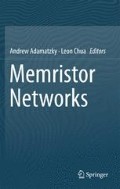Abstract
A novel memristor bridge circuit which is able to perform zero, negative and positive synaptic weightings in neuron cells is proposed. It is composed of four memristors and three transistors for weighting operation and voltage-to-current conversion, respectively. It is compact as it can be fabricated in nano meter scale. It is power efficient since it operates in pulse-based. Its input terminals are utilized commonly for applying both weight programming and weight processing signals via time sharing. By programming on each memristor of the memristor bridge circuit, the signed weighting values can be set on the memristor bridge synapses. The features of proposed architecture are investigated via various simulations.
Access this chapter
Tax calculation will be finalised at checkout
Purchases are for personal use only
Notes
- 1.
At least one state variable must appear explicitly in the definition of the memristance.
References
The Scientific American Book of the Brain. Scientific American, New York (1999)
Chua, L.O., Yang, L.: Cellular neural networks: theory. IEEE Trans. Circuits Syst. 35(10), 1257–1272 (1988)
Chua, L.O., Yang, L.: Cellular neural networks: applications. IEEE Trans. Circuits Syst. 35(10), 1273–1290 (1988)
Roska, T., Chua, L.O.: The CNN universal machine: an analogic array computer. IEEE Trans. Circuits Syst. II 40(3), 163–172 (1993)
Kim, H., Son, H., Roska, T., Chua, L.O.: Optimal path finding with space- and time-variant metric weights with multi-layer CNN. Int. J. Circuits Theory Appl. 30, 247–270 (2002)
Kim, H., Son, H., Roska, T., Chua, L.O.: High-performance Viterbi decoder with circularly connected 2-D CNN unilateral cell array. IEEE Trans. Circuits Syst. I 52, 2208–2218 (2005)
Domínguez-Castro, R., et al.: A 0.8-μm CMOS two-dimensional programmable mixed-signal focal-plane array processor with on-chip binary imaging and instructions storage. IEEE J. Solid-State Circuits 32(7), 1013–1026 (1997)
Cruz, J.M., Chua, L.O.: A 16×16 cellular neural network universal chip: the first complete single-chip dynamic computer array with distributed memory and with gray-scale input-output. Analog Integr. Circuits Signal Process. 15, 227–237 (1998)
Strukov, D.B., Snider, G.S., Stewart, D.R., Williams, R.S.: The missing memristor found. Nature 453, 80–83 (2008)
Shin, S., Kim, K., Kang, S.M.: Compact models for memristors based on charge-flux constitutive relationships. IEEE Trans. Comput.-Aided Des. Integr. Circuits Syst. 29(4), 590–598 (2010)
Joglekar, Y.N., Wolf, S.J.: The elusive memristor: properties of basic electrical circuits. Eur. J. Phys. 30(4), 661–675 (2009)
Kavehei, O., Iqbal, A., Kim, Y.S., Eshraghian, K., Al-Sarawi, S.F., Abboti, D.: The fourth element: characteristics, modelling and electromagnetic theory of the memristor. Proc. R. Soc. A 466(2120), 2175–2202 (2010)
Wang, F.Y.: Memristor for introductory physics (Aug. 4, 2008) arXiv:0808.0286v1 [physics. Class-ph]
Argall, F.: Switching phenomena in titanium oxide thin films. Solid-State Electron. 11, 535–541 (1968)
Chua, L.O., Kang, S.M.: Memristive devices and systems. Proc. IEEE 64(2), 209–223 (1976)
Chua, L.O.: Memristor-the missing circuit element. IEEE Trans. Circuit Theory CT-18(5), 507–519 (1971)
Itoh, M., Chua, L.O.: Memristor cellular automata and memristor discrete-time cellular neural networks. Int. J. Bifurc. Chaos (IJBC) 19(11), 3605–3656 (2009)
Kim, H., Sah, M.P., Changju, Y., Chua, L.O.: Memristor-based multilevel memory. In: 12th International Workshop on Cellular Nanoscale Networks and Their Appl. (CNNA), Feb. 2010
Xia, Q., et al.: Memristor-CMOS hybrid integrated circuits for reconfigurable logic. Nano Lett. 9(10), 3640–3645 (2009)
Borghettil, J., Snider, G.S., Kuekes, P.J., Yang, J.J., Stewart, D.R., Williams, R.S.: Memristive switches enable stateful logic operations via material implication. Nat. Lett. 464(8), 873–876 (2010)
Aono, M., Hasegawa, T.: The atomic switch. Proc. IEEE 98(12), 2228–2236 (2010)
Kozicki, M.N., Gopalan, C., Balakrishnan, M., Mitkova, M.: A low-power nonvolatile switching element based on copper-tungsten oxide solid electrolyte. IEEE Trans. Nanotechnol. 5(5), 535–544 (2006)
Waser, R., Aono, M.: Nanoionics-based resistive switching memories. Nat. Mater. 6, 833–840 (2007)
Jo, S.H., Chang, T., Ebong, I., Bhadviya, B.B., Mazumder, P., Lu, W.: Nanoscale memristor device as synapse in neuromorphic systems. Nano Lett. 1297–1301 (2010)
Snider, G.: Self-organized computation with unreliable, memristive nanodevices. Nanotechnology 18(36), 1–13 (2007)
Kund, M., Beitel, G., Pinnow, C.U., Röhr, T., Schumann, R., Symanczyk, R., Ufert, K.D., Müller, G.: Conductive bridging RAM (CBRAM): An emerging non-volatile memory technology scalable to sub 20 nm. IEDM Tech. Dig. 754–757 (2005)
Chua, L.O.: Resistance switching memories are memristors. Appl. Phys. A 102, 765–783 (2011)
Pickett, M.D., Strukov, D.B., Borghetti, J.L., Yang, J.J., Sinder, G.S., Stewart, D.R., Williams, R.S.: Switching dynamics in titanium dioxide memristive devices. J. Appl. Phys. 106, 074508 (2009)
Author information
Authors and Affiliations
Corresponding author
Editor information
Editors and Affiliations
Rights and permissions
Copyright information
© 2014 Springer International Publishing Switzerland
About this chapter
Cite this chapter
Kim, H., Sah, M.P., Yang, C., Roska, T., Chua, L.O. (2014). Memristor Bridge-Based Artificial Neural Weighting Circuit. In: Adamatzky, A., Chua, L. (eds) Memristor Networks. Springer, Cham. https://doi.org/10.1007/978-3-319-02630-5_12
Download citation
DOI: https://doi.org/10.1007/978-3-319-02630-5_12
Publisher Name: Springer, Cham
Print ISBN: 978-3-319-02629-9
Online ISBN: 978-3-319-02630-5
eBook Packages: Computer ScienceComputer Science (R0)

